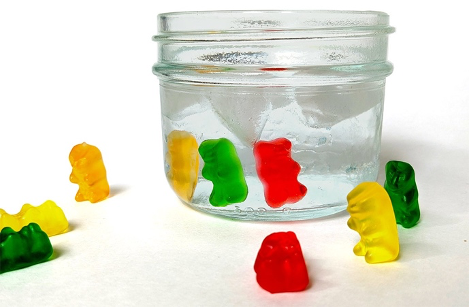November At-Home STEAM Activity: Sweet Experiment
This November, let’s conduct a sweet science experiment using your favorite candy!
What is your favorite type of candy? Have you ever wondered why you like this candy so much? Is it its taste, how it feels in your mouth, or both?
Cooks and food scientists study how substances dissolve or melt to create a unique and pleasant sensation in the mouth and optimize the release of flavor. Would you like to know how your favorite candy works? In this science experiment, you will study two types of candy and discover what makes them so enjoyable.
The Science Behind the Fun
Whether or not solids dissolve in water depends on how strong the internal bonds are, and how eager they are to bond with water. For example, to dissolve sugar in water, bonds between sugar molecules must be broken. This requires energy. Luckily, the creation of new bonds between sugar and water releases enough energy to break those bonds so that sugar can dissolve in water. If the released energy is less than the energy required, the solid will not dissolve. Temperature plays a role as well. Adding heat means adding energy, so with most solids, the hotter the water, the easier and faster it is to dissolve the solid. Heated molecules move around quicker than unheated molecules.
Materials
- Four glasses
- 1/3 cup of Cold water
- 1/3 cup of Hot water
- Pen and sticky notes
- Gummy bears and hard candy (like fruit drops)
- Two timers or a clock
- Spoons and two plates
Preparation
- Protect your workspace from splashes of water.
- Fill two glasses each with 1/3 cup of cold water.
- Label two sticky notes with “Cold water” and two more with “Hot water.”
Procedure
- Place two gummy bears in the first glass of water, then remove the wrappers of two hard candies and place them in the second glass. Identify this row of glasses with the “cold water” sticky notes. Set the first timer to 30 minutes or use the clock to track the time.
- Repeat step 1 with hot water and candy.
- Label 1 plate cold water and 1 plate hot water using sticky notes.
- After the first 30 minutes are over, it is time to observe the candy submerged in cold water. Use a spoon to carefully pick the candies out of the two glasses in the “cold water” row and place them on the plate labeled “cold water.” Set aside. For each of these glasses, take a clean spoon to stir the water, scoop up a sample of the water, and taste it. Which one is sweet?
- Take a new gummy bear and hard candy, remove the wrapper if needed, and place the candy next to the candies that have been soaked for 30 minutes. What differences do you observe? Is what you observe consistent with what you expected? If it is different, why do you think this is the case?
- Repeat with hot water after 30 minutes.
Looking at the change in the size of the candies and the taste of the water, what do you think happened to each type of candy when submerged in water? How is the candy soaked in hot water different from the same type of candy soaked in cold water? Why do you think this has occurred?
Pop a candy from the bag in your mouth. Notice how your mouth is a watery environment that is at body temperature. How do you think your previous observations relate to the feel and taste of the candies in your mouth?
Observations and Results
Did you see that the hard candies dissolved in cold water, while the gummy bears puffed up? Did hot water dissolve the hard candies faster, while the gummy bears started to melt in the hot water? This is expected.
Hard candy is made of sugar, corn syrup, and other substances that dissolve easily in water. Just like the saliva in your mouth, the water in the glass allowed them to dissolve. Adding heat made this process easier and faster. While the candy dissolved layer by layer, it got smaller and smaller and more and more sugar, syrup, and taste chemicals dispersed in the water. That is why the water tasted sweet, like the candies.
Gummy bears, on the other hand, contain gelatin, which gives it its typical soft texture. The gelatin creates a mesh of entangled long molecules that hold the gummies together. The structure has pockets that can absorb water through a process called osmosis. That is why the gummies swell up when soaked in cold water. The water stays tasteless. It was different when you submerged the gummies in hot water: as the temperature of the hot water was above the melting temperature of gelatin, the outer layer of the gummies melted away. The gummy bears got smaller and smaller, and you could see tiny pieces of gummy bear floating in the water. These pieces make the water taste sweet, like the gummy bears.
